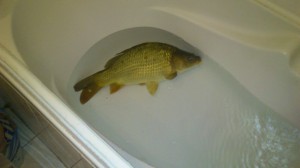Europe is diverse. This should not come as news to any true AEGEEans! But how diverse is Europe when it comes to Christmas traditions? The AEGEEan asked around to find out more about certain customs, meals and luck-bringing traditions from different countries. Obviously, not every single country could be mentioned, but another edition next year might follow anyways!
The AEGEEan wishes all of you a very European Christmas!
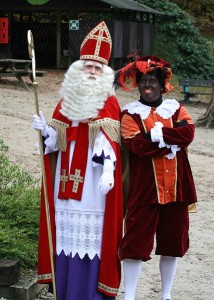 Let’s start chronologically with something very special that actually has not too much to do with Christmas, but still involves a bearded man in a red coat bringing presents: this rather well-known December tradition comes from the Netherlands! Every AEGEEan who attended an event in beautiful Holland around Christmas time will surely have heard about Sinterklaas. This celebration, which takes place on December 5th, is a huge event. Sinterklaas, alongside with his companion, de Zwarte Piet (Black Pete), comes to the Dutch children via boat from Spain and brings presents to the ones who have been good, while the ones who have been naughty might get put in Piet’s bag and brought back to Spain.
Let’s start chronologically with something very special that actually has not too much to do with Christmas, but still involves a bearded man in a red coat bringing presents: this rather well-known December tradition comes from the Netherlands! Every AEGEEan who attended an event in beautiful Holland around Christmas time will surely have heard about Sinterklaas. This celebration, which takes place on December 5th, is a huge event. Sinterklaas, alongside with his companion, de Zwarte Piet (Black Pete), comes to the Dutch children via boat from Spain and brings presents to the ones who have been good, while the ones who have been naughty might get put in Piet’s bag and brought back to Spain.
While Christmas Eve itself is not celebrated that eagerly in the Netherlands, as Laura van Deursen, AEGEE-Delft, explains, the 25th and 26th are usually used to visit the family.
Again, somebody else than Santa himself brings presents to children in Verona and some other cities in Italy: “We have Saint Lucia, who comes on the 12th of December at night and brings presents and sweets to children“, Cristina Rolli from AEGEE-Verona explains. Normally, she has a donkey and the children prepare straw and a carrot for it and a glass of milk with biscuits for Saint Lucia the evening before she comes. The children should be sleeping when she arrives at the house, because otherwise she will throw coal in their eyes. Saint Lucia is blind and she can make blind whoever sees her during her night. Children – stay in your beds! And, as if one woman wasn’t enough, there is also la Befana. “She is a really old and ugly woman who also brings gifts to children, but in the night between January 5th and 6th”, says Cristina. This time, the children prepare socks, which are hung up by the fireplace so that la Befana can put sweets and presents inside when she arrives on her broom. And what do those kids get who were bad? Coal again!
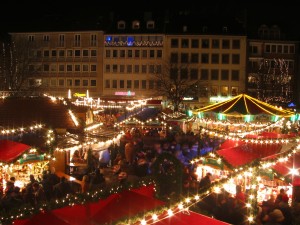 Two things seem especially important when it comes to Germany and Christmas: Christmas Markets and Glühwein. Which is also a very typical combination. Christmas Markets can be found in any bigger city and take place from the first Advent to the fourth (or in some cases until Christmas Eve itself). They range from rather small ones to really big ones, mostly depending on the size of the city. Also the variety of products is rather unimaginable and covers around anything that people might want to give others as a present for Christmas. Most importantly though, one can buy lots and lots of unhealthy, delicious food and Glühwein!
Two things seem especially important when it comes to Germany and Christmas: Christmas Markets and Glühwein. Which is also a very typical combination. Christmas Markets can be found in any bigger city and take place from the first Advent to the fourth (or in some cases until Christmas Eve itself). They range from rather small ones to really big ones, mostly depending on the size of the city. Also the variety of products is rather unimaginable and covers around anything that people might want to give others as a present for Christmas. Most importantly though, one can buy lots and lots of unhealthy, delicious food and Glühwein!
The best Glühwein recipe is arguable and everybody will do it slightly differently. Nevertheless, the main ingredients are dry red wine, sugar, orange/lemon slices and maybe a little bit of their juice, and herbs (clove, cinnamon, star anise). Heat it up, allow the herbs to infuse, but never let it boil! Prost!
And if you want to have the real German experience, also concerning food, prepare some sausages and potato-salad, a simple dish that is often served on Christmas Eve when Germans eat with their families. The (very polite) idea behind that basic meal is that the mother of the family won’t have to spend the whole day in the kitchen cooking, but with her loved ones instead. Germans are nice after all.
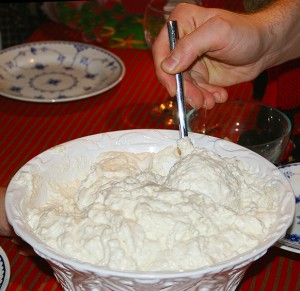 While already talking about food, Denmark has a nice tradition, especially when it comes to their dessert. After eating some sort of roast meat with potatoes, gravy and red cabbage or other vegetables on Christmas Eve, they serve Risalamande, which derives from the French ris à l’amande, meaning rice with almonds. Nowadays, it is very common to serve a very large bowl of plain rice pudding on 23rd December already, the so called lillejuleaften, literally meaning “little Christmas Eve“. Some rice pudding is then kept for Christmas Eve and additionally mixed with whipped cream, chopped almonds and vanilla, often served with a cold cherry sauce on top.
While already talking about food, Denmark has a nice tradition, especially when it comes to their dessert. After eating some sort of roast meat with potatoes, gravy and red cabbage or other vegetables on Christmas Eve, they serve Risalamande, which derives from the French ris à l’amande, meaning rice with almonds. Nowadays, it is very common to serve a very large bowl of plain rice pudding on 23rd December already, the so called lillejuleaften, literally meaning “little Christmas Eve“. Some rice pudding is then kept for Christmas Eve and additionally mixed with whipped cream, chopped almonds and vanilla, often served with a cold cherry sauce on top.
Jenny Rooseboom from AEGEE-Aachen, who spent her Erasmus semester in Denmark, tells us that even though Risalamande is a really heavy dessert, “it really is necessary to finish it since there is one whole almond hidden in one of the portions. The one catching the almond gets a present and will have good luck for the upcoming year.”
“Christmas in Slovakia is very similar to all kinds of Slavic Christmases”, says Lucia Gavulová from AEGEE-Bratislava. The most important part of the celebrations is Christmas Eve when the whole family gathers around the table. And they are hungry, because during the day it is not allowed to eat – at least if you want to receive a special reward: to see a golden pig. The food itself doesn’t involve any meat though, but mostly consists of carps with a special potato salad.
Lucia goes on to tell us about some other lucky traditions: “Because we used to be a poor country, we use many traditions to call for money – putting a carp scale under the plate, eating poppy seeds (to have as much money as poppy seeds in a plate) or washing our hands in water filled with coins. And because we really appreciate being healthy, we cut an apple horizontally and if there is nice a star in the middle, the whole family will be healthy.” And to be really sure that they all stay healthy, the Slovakian people eat a special kind of wafer with honey and garlic to protect themselves from diseases.
Similar to Slovakia, the typical Czech Christmas dinner consits of fried or baked carp served with potato salad. The carp has to be really fresh, the family will buy it when it’s still alive and put it in their bathtub until its preparation. Don’t get too attached the hours of the carp’s life are numbered!
Another typical Czech Christmas meal is called Kuba and it is prepared from hulled grain and mushrooms. Barbora Heresová from AEGEE-Praha tells us that “during the Christmas dinner no one can stand up from the table, otherwise it would mean a death for a family member in the next year”. Also, Czech people, like some other countries from the middle of Europe always set the table for one more person, in case a wanderer comes by. Presents in the Czech Republic are being delivered by Ježíšek. No child knows how he looks like because he is too shy and only adults are allowed to meet him and take the presents from him (how convenient!). Once Ježíšek is gone, there is a bell ringing which means the presents are under the tree and children can go unwrap them.
In Poland – as a rather religious country – many traditions and customs originate from Christianity. “Polish People take the Advent time very seriously and want to prepare their soul to the day when Christ was born”, Agata Cichonska, current member of AEGEE-Alicante, tells us. 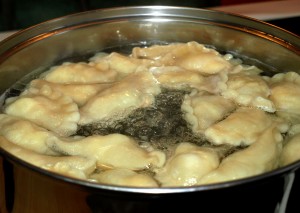 The main part of Wigilia is a solemn family supper, which starts right after the appearance of the first star in the sky. The traditional Christmas Eve supper consists of twelve dishes representing the twelve months of the year or twelve apostles. No meat is served during the supper, only fish, usually herring, carp or pike. Other traditional dishes appearing on the table include red borscht, mushroom or fish soup, sauerkraut with wild mushrooms or peas, dried fruit compote and kutia, a dessert especially popular in eastern Poland. For the Christmas Eve supper, pierogis, a well-known Polish dish, are usually made with sauerkraut and mushrooms and either fried or boiled. Agata explained two other very special Polish traditions to us: “Hay on the table is another traditional symbol. Normally we put hay on the table and cover it under the tablecloth. It´s because of the fact, that Jesus Christ was born on the hay in the stable. And we always have one candle on the table, as a sign of the presence of God. We light it while the Evangel is read. Normally, the eldest member of the family is reading correspondent fragment of Evangel. And after this moment we share the wafer!
The main part of Wigilia is a solemn family supper, which starts right after the appearance of the first star in the sky. The traditional Christmas Eve supper consists of twelve dishes representing the twelve months of the year or twelve apostles. No meat is served during the supper, only fish, usually herring, carp or pike. Other traditional dishes appearing on the table include red borscht, mushroom or fish soup, sauerkraut with wild mushrooms or peas, dried fruit compote and kutia, a dessert especially popular in eastern Poland. For the Christmas Eve supper, pierogis, a well-known Polish dish, are usually made with sauerkraut and mushrooms and either fried or boiled. Agata explained two other very special Polish traditions to us: “Hay on the table is another traditional symbol. Normally we put hay on the table and cover it under the tablecloth. It´s because of the fact, that Jesus Christ was born on the hay in the stable. And we always have one candle on the table, as a sign of the presence of God. We light it while the Evangel is read. Normally, the eldest member of the family is reading correspondent fragment of Evangel. And after this moment we share the wafer!
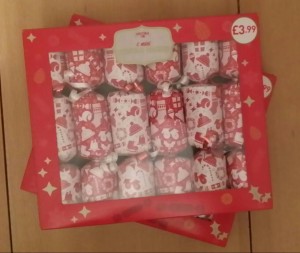 Something less religious is shared in England: Christmas Crackers! During Christmas dinner, everyone around the table receives a Christmas cracker (they’re usually used as table decoration). “After dinner, you hold your cracker in one hand and your neighbours’ in the other to make a ring around the table and you pull at your ends, everyone simultaneously”, tells us Kathrin Peirera, who lives in North East England right now. “They open with a mini explosion and inside is a small gift (typically something like a mini measuring tape, a whistle or marbles), a paper crown which you should put on your head and a short joke you read out loud to the others (typical Christmas cracker jokes: What happens to an egg if you tell it a joke? – it cracks up!)”
Something less religious is shared in England: Christmas Crackers! During Christmas dinner, everyone around the table receives a Christmas cracker (they’re usually used as table decoration). “After dinner, you hold your cracker in one hand and your neighbours’ in the other to make a ring around the table and you pull at your ends, everyone simultaneously”, tells us Kathrin Peirera, who lives in North East England right now. “They open with a mini explosion and inside is a small gift (typically something like a mini measuring tape, a whistle or marbles), a paper crown which you should put on your head and a short joke you read out loud to the others (typical Christmas cracker jokes: What happens to an egg if you tell it a joke? – it cracks up!)”
We hope you enjoyed our Christmas Special and wish you all the best for your personal Christmas, however it looks like!
Written by Katja Sontag, AEGEE-Aachen



